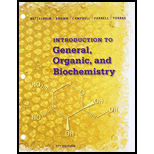
Interpretation:
To write an equilibrium expression for given equilibrium reaction.
Concept Introduction:
Equilibrium reaction:
A
Or
Equilibrium expression:
It denotes the ratio of product and reactants in concentration term that is expressed by K (equilibrium constant).
Consider an equilibrium reaction:
Here, a, b, c and d are coefficient.
So, the equilibrium expression for above reaction would be.
Want to see the full answer?
Check out a sample textbook solution
Chapter 7 Solutions
Bundle: Introduction to General, Organic and Biochemistry, 11th + OWLv2, 4 terms (24 months) Printed Access Card
- Problem 7-7 Consider the following equilibrium reaction for the decomposition of an aqueous solution of hydrogen peroxide: Oxygen has limited solubility in water (see the table in Chemical Connections 6A). What happens to the equilibrium after the solution becomes saturated with oxygen?arrow_forward7-41 The equilibrium constant at 1127°C for the following endothermic reaction is 571: If the mixture is at equilibrium, what happens to K if we: (a) Add some H2S? (b) Add some H2? (c) Lower the temperature to 1000°C?arrow_forward7-31 Here are equilibrium constants for several reactions. Which of them favor the formation of products, and which favor the formation of reactants? (a) (b) 32 (c) 4.5 (d) (e) 0.0032arrow_forward
- 7-71 You have a beaker that contains solid silver chloride (AgCl) and a saturated solution of Ag+ and CI- ions in equilibrium with the solid. You add several drops of a sodium chloride solution. What happens to the concentration of silver ions?arrow_forwardK = 9 K = 3 At equilibrium? At equilibrium? no yes O yes no X%3D2 At equiibrum7 At equilibr Jm7 yes ves no Explanation Check 1Larrow_forwardConsider the equilibrium 2A + B⇌C At equilibrium the following concerntrations are measured A = 0.277 mol L-1 B = 1.26 mol L-1 C = 0.203 mol L-1 Calculate the equilibrium constant Kcarrow_forward
- l Verizon ? 1:11 AM 77% 4 Question 4 of 7 Submit Consider the following reaction at equilibrium CO(g) + H20(g) =CO2(g) + H2(g) If CO(g) is removed, in which direction will the equilibrium shift? A) reactants B) products C) no change Tap here or pull up for additional resourcesarrow_forwardCheck Your Understanding In each of the following, determine the direction in which the equilibrium will shift in response to the indicated stress. (a) N2 (g) + 3 H2 (g) 2 2 NH3 (g); pressure is decreased Answer + Shift toward reactants (b) CO2(g)+ H2 (g) 2 CO(g) +H2O(g); pressure is increased Answer no changearrow_forwardsession.mas eringchemistry.com/myct/itemView?assignmentProblemID=1743438908&offset3Dnext Homework CH16 Part 3 omework Problem 4 I Review I Constam The reversible chemical reaction A+B C+D Part A has the following equilibrium constant: [C]D] K. = [A]B] = 4.5 Initially, only A and B are present, each at 2.00 M. What is the final concentration of A once equilibrium is reached? Express your answer to two significant figures and include the approprlate units. > View Available Hint(s) HA ? [A] = Value Units Submit Part B What is the final concentration of D at equilibrium if the initial concentrations are [A] = 1.00 M and B = 2.00 M? Express your answer to two significant figures and include the appropriate units. > View Available Hint(s) [D] = Value Units Submit MacBook Airarrow_forward
- At 448°C, the equilibrium constant for the reaction: H₂+I22 HI is 50.5. What concentration of I2 would be found in an equilibrium mixture in which the concentrations of HI and H₂ were 0.540 M and 0.055 M, respectively? Submit Answer M Try Another Version 10 item attempts remainingarrow_forwardarrow_back_iosSEE MORE QUESTIONSarrow_forward_ios
 Introduction to General, Organic and BiochemistryChemistryISBN:9781285869759Author:Frederick A. Bettelheim, William H. Brown, Mary K. Campbell, Shawn O. Farrell, Omar TorresPublisher:Cengage LearningChemistry: Matter and ChangeChemistryISBN:9780078746376Author:Dinah Zike, Laurel Dingrando, Nicholas Hainen, Cheryl WistromPublisher:Glencoe/McGraw-Hill School Pub Co
Introduction to General, Organic and BiochemistryChemistryISBN:9781285869759Author:Frederick A. Bettelheim, William H. Brown, Mary K. Campbell, Shawn O. Farrell, Omar TorresPublisher:Cengage LearningChemistry: Matter and ChangeChemistryISBN:9780078746376Author:Dinah Zike, Laurel Dingrando, Nicholas Hainen, Cheryl WistromPublisher:Glencoe/McGraw-Hill School Pub Co

